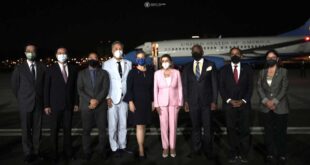Hellmut Koller
he Treaty on the Prohibition of Nuclear Weapons (TPNW), adopted in 2017, has entered into force on the 22nd of January of this year and the number of ratifying states continues to grow, with Mongolia being the latest to announce its accession. This positive trend is certainly welcomed with enthusiasm by the Civil Society campaigners and growing number of supporters of this treaty that represents a huge step forward for the global movement to draw attention to the catastrophic humanitarian consequences of any use of nuclear weapons. It would certainly be dishonest to ignore the fact that this new international legal instrument remains controversial, to say the least, for most of the members of the so-called nuclear deterrence community. As preparations are ongoing for the first Meeting of States Parties, scheduled to take place in Vienna on 22-24 March 2022, it is useful to address some of the main doubts and arguments against the treaty.
In this regard, the main criticism is that it makes no sense to support a treaty on nuclear weapons if those states that possess them have not joined nor any intention to join it.
In order to address this claim, it may be useful to recall that in the case of the Mine Ban and the Cluster Munition treaties, its main promoters and supporters were also states that did not possess those weapons, and that those international instruments also received some harsh criticism for this reason. Despite of this, there is no doubt now that both of those treaties have become remarkable success stories, not only by achieving the goal of approaching universalization, but also by consolidating a general moral condemnation of those categories of weapons. Therefore, the argument that a treaty necessarily needs to be joined by the possessors of the weapons can easily be rebutted. Despite of the current position of the nuclear weapons states, each new ratification of the treaty is not meaningless: on the contrary, it provides the treaty more authority and contributes to the growing pressure on nuclear weapons states to adopt further steps towards nuclear disarmament.
The other major contribution of the TPNW is that it facilitates the process of delegitimisation of nuclear weapons, necessary to finally amend the well-established foundations of nuclear deterrence doctrines. The humanitarian principles that are underlying the treaty are totally incompatible with those doctrines, and therefore are having an impact on them by highlighting the inherent immorality and illegitimacy of nuclear weapons.
Another argument for the case of ratification is that it provides states the opportunity to support the process of democratization of the global debate on nuclear weapons, as this new treaty has been the result of a very open discussion with active engagement of delegations from all geographic regions and, in particular, of representatives of Civil Society. This is not a minor aspect of this process, but a key element. Indeed, unlike in negotiations of previous international legal instruments, in this era of growing complexity and interlinkages, the main challenges faced by humankind are being addressed by a diverse group of citizens, from all walks of life and regions. Traditional diplomacy is certainly not enough, and in the case of the TPNW, the positive results would clearly not have been possible without the decisive boost provided by the International Campaign to Abolish Nuclear Weapons (ICAN), which was able to mobilize Civil Society and likeminded governments towards the goal of negotiating a nuclear weapons ban treaty.
While it would be naïve to expect the establishment of the nuclear weapons states to be convinced by the humanitarian narrative and in a foreseeable future to amend its defence and security policies base on nuclear deterrence, the TPNW and its focus on the security of the human being instead of the traditional notion of the security of the state, are already having an impact on the academic and public debates in those states.
The second argument used by its critics is that the TPNW weakens the Non-Proliferation Treaty (NPT). Actually, this is not only incorrect, the opposite is true. In fact, the TPNW can serve as an initiative to help implement article VI of the NPT, by which parties are committed to undertake to “pursue negotiations in good faith on effective measures relating to cessation of the nuclear arms race at an early date and to nuclear disarmament”. This is of vital importance as the treaty clearly attaches a key role to all parties, and not only to those states that possess nuclear weapons. This commitment has also been reflected in the Final Document of the 2010 NPT Review Conference, and the TPNW can be understood as a reflection of that obligation to contribute to nuclear disarmament by non-nuclear weapons states.
Another common point is that the nuclear weapons industry is too strong and well consolidated and that it would be naïve to pretend that this treaty could actually have an impact on investment decisions.
This pessimism has also been proven wrong. In fact, in 2021, more than one hundred financial institutions are reported to have decided to stop investing in companies related to nuclear weapons production. As a result, the nuclear weapons industry is experiencing a considerable reduction and the trend towards the exclusion of this sector from investment targets is growing steadily. This is not only the consequence from the legal obligations that emanate from the TPNW but a reflection of the devaluation of the public image associated to these industries. As this public image continues to deteriorate, it is likely that this trend will continue and that the moral condemnation of these weapons of mass destruction will be absorbed into the mainstream of society.
Another common misinterpretation is that the TPNW should be understood as an instrument that is only designed to be joined exclusively by non-nuclear weapons states.
In fact, even though the treaty was developed by non-nuclear weapons states, it has been drafted and negotiated with the goal of universal adherence, including, someday, those states that still include nuclear deterrence in their national security doctrines. In particular, the TPNW establishes a clear set of steps for nuclear weapons states in order to eliminate their arsenals of nuclear weapons. Specifically, within 60 days after the entry into force of the treaty for a state party that possesses nuclear weapons, that state must submit a plan for the complete elimination of its nuclear weapons to a competent international authority that has been specially designated by states parties. The treaty also includes a process to designate a competent international authority to verify the elimination of nuclear weapons by a state before acceding to the treaty, and a process for states parties that maintain nuclear weapons in their territories for the removal of these weapons and report this action to the United Nations Secretary General.
It is also noteworthy that this treaty obliges states parties to provide adequate assistance to victims affected by the use or by testing of nuclear weapons, and to take the necessary measures for environmental rehabilitation in areas contaminated under its control. This dimension of the treaty constitutes an important contribution both to the protection of human rights of victims and to the now inescapable obligation to protect the environment, which are aspects that are not covered by the Comprehensive Nuclear Test Ban Treaty (CTBT). This certainly does not affect the value and vital role of this key instrument of the nuclear disarmament and non-proliferation regime but complements it by addressing the fundamental issue of environmental reparation.
The main challenge now is now not only to achieve a wider universality of the TPNW, but to engage more stakeholders and create awareness on the urgency of bringing pressure on the nuclear weapons states to finally move toward nuclear disarmament. In this regard, Civil Society initiatives have been promoting engagement of members of grassroots, parliament, the media and city governments, particularly in nuclear weapons states, which has had impressive results, with hundreds of local governments expressing support for the treaty and generating discussion among the population. These initiatives serve the purpose of putting pressure on politicians and especially, to facilitate a discussion within democratic societies about the sustainability and risks involved in the possession and harboring of nuclear weapons.
Indeed, the TPNW has a long way to go and overcome many obstacles to achieve its objective, but in its first year of entry into force, it has already had an undeniable impact on the nuclear disarmament and non-proliferation debate, despite the expected skeptics and efforts to ignore its existence stemming from the still powerful nuclear deterrence establishment. Most of its technical experts, academics and government officials honestly believe that nuclear weapons have helped to guarantee peace and stability to the world and therefore should continue as the foundation of international security doctrines. These well-established ideas have been based on the questionable assumption that the deployment of these weapons have avoided war and can guarantee permanent peace for all nations. This has served as a sort of dogmatic idea for many decades, but recent research results have shown that the risks involved are significantly higher and that the humanitarian consequences would be catastrophic for every citizen of the planet. The humanitarian impact paradigm, which underlies the process that has inspired the TPNW, has provoked a tectonic shift in the nuclear disarmament and non-proliferation debate, which had been limited to the NPT review conferences with its often-frustrating results. Certainly, the persistence of the different approaches needs to be addressed in a more constructive discussion among the supporters of this treaty and the deterrence community.
Finally, the fact that the first meeting of states parties of the TPNW will take place in Vienna is very meaningful as Austria has been one of the leading nations in this process, particularly in drafting the Humanitarian Pledge to fill the legal gap for the prohibition of nuclear weapons, which has been a decisive step towards the treaty that has already fulfilled that commitment. Despite of all the difficulties and the persistence of significant resistance, the active and committed participation of diplomats and Civil Society representatives, under the leadership of Austria, allow to envisage that this first meeting will help to strengthen the treaty and move forward in the long and burdensome road to the final objective of achieving a world free of nuclear weapons.
 Geostrategic Media Political Commentary, Analysis, Security, Defense
Geostrategic Media Political Commentary, Analysis, Security, Defense





